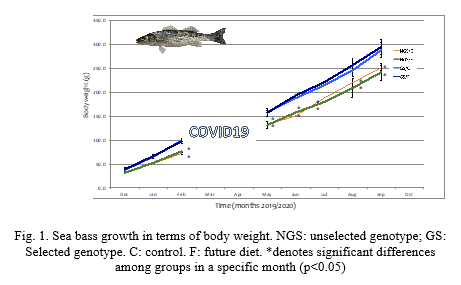NUTRITIONAL INNOVATIONS IN SUPERIOREUROPEAN SEA BASS Dicentrarchus labrax GENOTYPES: IMPLICATIONS IN FISH PERFORMANCE AND GUT HEALTH
Introduction
A proper development of the aquaculture sector implies: (a) an effective replacement of marine raw ingredients (fish meal, FM; fish oil, FO) by sustainable raw materials and (b) a successful breeding program addressed to improve growth, feed utilization and fish health. Thus, the formulation of diets for genetically selected European sea bass (Dicentrarchus labrax ) to determine how the interaction of breeding programs and nutrition together determines fish performance and diet utilization is needed, being the aim of the present study .
Materials and methods
During a production cycle a sea bass selected genotype (GS) and an unselected (wild) genotype (NGS) (15 ± 0.5 g initial mean weight), were fed a control diet with a low content of FM/FO based in nowadays commercial formulations and a “future” diet based on low FM/FO contents but formulated to cover the predictable sea bass requirements of the GS and enable them to completely express their growth and feed utilization potential . Fish were fed for nine months in triplicate (3 replicates/diet/genotype ). Growth performance and feed utilization were monitored along the feeding trial. Additionally, at the beginning (t=0) and at the end of the feeding trial (t=9 months), fish were sampled for fillet biochemical composition and fatty acid profiles (15 fish/diet/genotype ), morphological evaluation of the intestine (9 fish/diet/genotype) , microbiota (6 fish/diet/genotype) and gene expression analyses (6 fish/diet/genotype) .
Results
Sea bass genotype markedly affected fish performance. After 8 weeks of feeding GS sea bass presented higher weight gain than NGS, regardless of the diet fed (Fig. 1). This marked effect was maintained to the end of the experiment . Fillet biochemical composition results indicated that GS fish present higher (p<0.05) lipid and lower ash (p<0.05) percentages than NGS fish. Fish fed Future diet presented higher (p<0.05) lipid content than fish fed control diet. Besides, a significant interaction (p<0.05) between genotype *diet was detected for ash and protein content. Fish fed future diet presented higher (p<0.05) liver lipid content in expenses of protein, ash and protein percentages. A significant interaction (p<0.05) between genotype*diet was detected for moisture liver content. Fillet and liver fatty acid profiles will be also discussed.
In terms of intestine gene expression, responsiveness to the feeding trial was more relevant in posterior section, where a significant interaction (p<0.05) between strain*genotype was found in the expression of cd4, il-1β, il-10, mhc ii, and tnf-α genes . Specifically, il-1β was up regulated in distal intestine of NGS fish compared to GS Europen sea bass , while tnf-α expression was up regulated (p<0.05) in GS fish fed future diet compared to fish fed the control diet . The expression of il-10 was up regulated (p<0.05) in GS fish compared to NGS fish. These results were correlated with the morphology patterns observed in both intestinal regions .
The reduction of gut microbiome biodiversity was more evident in GS than in NGS fish .
Concerning gut microbiome analysis, a reduced biodiversity and species richness were found in fish fed experimental diets compared to their T0, but not among them .
At family level, Lactobacillaceae , Streptococcaceae , Staphylococcaceae , and Peptostreptococcales-Tissierellales were significantly less abundant in GS fish than in NGS fish, regardless of the diet . Accordingly, Lactobacillus and Streptococcus genera were absent in the same fish. In contrast, in NGS fish the presence of Acinetobacter, Staphylococcus , and Pseudomonas was detected.
In summary, our data indicated a higher influence of the genotype on D. labrax growth performance, than the diet formula fed. However, the diet formula influenced the composition of the fillet and the liver as well as their fatty acid profile. On the other hand, the genotype had a slight influence in modulating the resident intestinal microbiota composition compared to the GS strain , but NGS fish showed the presence of opportunistic pathogenic bacteria in their intestine. The NGS strain revealed a trend to show a like-chronic inflammatory status, that was more evident in fish fed future diet.
Acknowledgements
This research was funded by the EU Horizon 2020 project AquaIMPACT (Genomic and nutritional innovations for genetically superior farmed fish to improve efficiency in European aquaculture) ; number: 818367.
